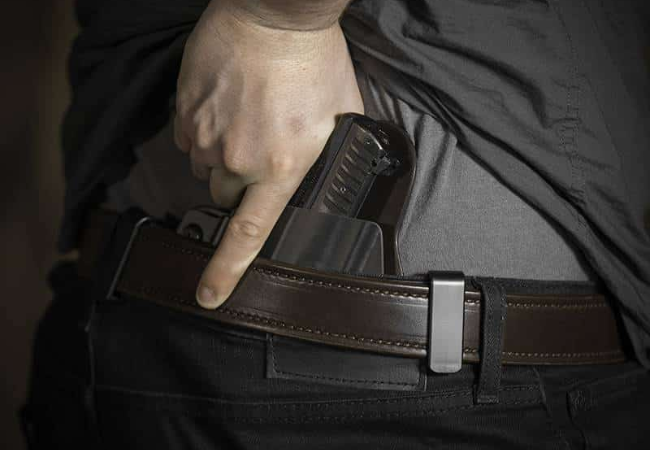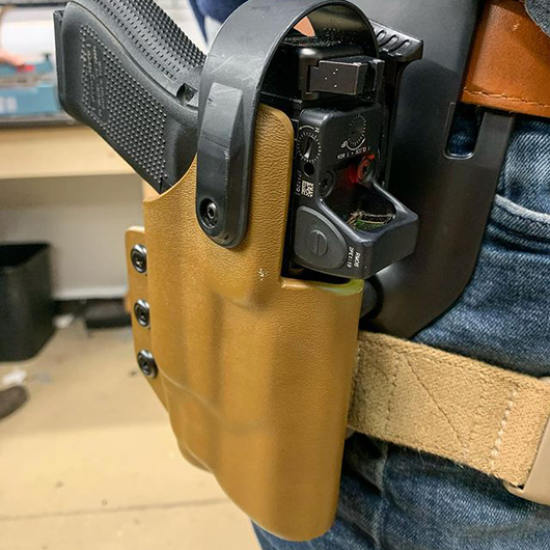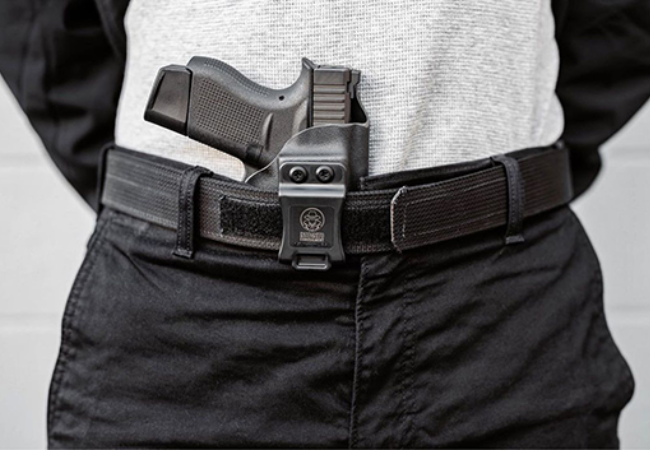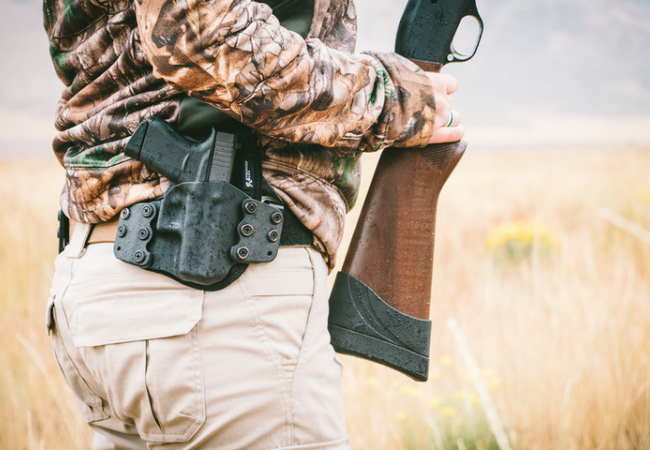When it comes to personal protection and carrying a firearm, the choice between Inside the Waistband (IWB) and Outside the Waistband (OWB) holsters is paramount.
These two types of carrying methods offer distinct advantages and can be tailored to individual preferences and needs.

The Paddle holster, popular in OWB configurations, allows for easy accessibility, while options like the sleeveless shirt can influence the comfort of an IWB holster.
Professionals such as law enforcement officers often prefer OWB carrying, using accessories like the police duty belt to hold their Handgun holster securely.
Whether for civilian use or professional service, the IWB versus OWB debate requires careful consideration of various factors, including comfort, concealment, and accessibility.
This article explores these two methods, shedding light on their unique characteristics and practical applications.
Iwb And Owb: What’s That Mean?
Inside the Waistband (IWB) and Outside the Waistband (OWB) are terms that refer to two distinct methods of carrying a handgun, often used by civilians, law enforcement, and other security professionals.
- IWB (Inside the Waistband): This method involves attaching the holster inside the pants’ waistband, typically concealed by a shirt or jacket. It offers increased concealment but may require specific clothing choices for optimal comfort, such as a sleeveless shirt that won’t interfere with the holster. IWB can be more discreet and is a popular choice for concealed carry permit holders.
- OWB (Outside the Waistband): As the name suggests, OWB holsters are worn on the outside of the pants, often attached to a belt or a specialized accessory like a police duty belt. This method offers more comfort and quicker access to the firearm. The Paddle holster, a type of OWB holster, is especially well-liked for its ease of attachment and removal. However, OWB is generally more visible, making it a preferred option for law enforcement or open carry enthusiasts.
Both IWB and OWB have specific advantages and potential drawbacks, depending on the user’s needs and preferences.
Understanding these differences can help individuals choose the most appropriate method for their situation, whether they prioritize concealment, comfort, accessibility, or a combination of these factors.
Feature differences B/W OWB vs IWB holster
Comfort: Inside the Waistband (IWB) vs. Outside the Waistband (OWB)
Carrying a firearm requires careful consideration of both comfort and functionality. Two common methods, Inside the Waistband (IWB) and Outside the Waistband (OWB), each offer distinct comfort features. Here’s how they compare:
Inside the Waistband (IWB)
IWB holsters are worn inside the pants, typically concealed by a shirt or jacket. This method is known for its excellent concealment but can be more challenging in terms of comfort.

- Body shape, size, and holster positioning greatly influence comfort levels.
- Clothing compatibility matters, with loose or stretchable clothing like a sleeveless shirt making the IWB method more comfortable.
- Weather and seasonal changes might affect comfort, as the holster is in direct contact with the skin.
Outside the Waistband (OWB)
OWB holsters are worn outside the pants and offer more ease of movement and comfort, especially for those carrying larger firearms.

- Paddle holsters, a popular OWB option, are known for easy attachment and removal.
- A police duty belt can provide additional support for OWB carry, often preferred by law enforcement.
- The OWB method allows for more breathing room, reducing sweat and irritation.
Comparing IWB and OWB, the choice often boils down to individual preferences and the intended use of the firearm.
While IWB offers better concealment, it may compromise on comfort. On the other hand, OWB is generally more comfortable but less discreet.
Balancing these factors and understanding how they align with one’s daily routine and requirements is essential to making an informed choice.
Concealment: Inside the Waistband (IWB) vs. Outside the Waistband (OWB)
The ability to conceal a firearm is a vital consideration for many gun owners, especially for those who carry concealed weapons. Here’s how the IWB and OWB methods compare in terms of concealment:
Inside the Waistband (IWB)
IWB holsters are designed for concealment, and many consider them the superior choice for hiding a firearm.
- Visibility: IWB holsters are tucked inside the pants, significantly reducing the visibility of the firearm.
- Clothing Compatibility: Normal clothing can conceal an IWB holster. Choices like a loose shirt or a jacket can further aid in hiding the firearm.
- Printing Prevention: Some IWB holsters are designed to minimize printing, where the outline of the gun becomes visible through clothing.
Outside the Waistband (OWB)
OWB holsters are generally more visible, making concealment more challenging.
- Visibility: The firearm and holster are outside the pants, making them more apparent, especially with tight or light-colored clothing.
- Cover Garment Requirement: Concealing an OWB holster often requires a cover garment like a jacket or a loose, untucked shirt.
- Law Enforcement Use: OWB holsters are commonly used by police and security professionals, where concealment is not the primary concern.
Durability: Inside the Waistband (IWB) vs. Outside the Waistband (OWB)
The durability of a holster is essential, as it must withstand daily wear and tear while securely holding the firearm.
Inside the Waistband (IWB)
IWB holsters are subjected to more body contact, sweat, and friction, which can affect their longevity.

The choice of materials, craftsmanship, and regular maintenance can significantly influence the durability of an IWB holster. A good quality IWB holster designed for a specific handgun model will typically last longer.
Outside the Waistband (OWB)
OWB holsters are generally exposed to less bodily wear but more environmental factors. The durability of OWB holsters often relies on the quality of materials, such as leather or Kydex, and construction.
OWB holsters are more accessible for inspection and maintenance, which can contribute to a longer lifespan.
Maintenance: Inside the Waistband (IWB) vs. Outside the Waistband (OWB)
Regular maintenance ensures that a holster remains functional and safe. The processes for maintaining IWB and OWB holsters have some differences.
Inside the Waistband (IWB)
IWB holsters require vigilant maintenance as they are often in contact with the body, leading to sweat and moisture exposure. Regular cleaning, inspection for wear and tear, and proper storage are vital for maintaining an IWB holster.
Outside the Waistband (OWB)
OWB holsters are generally easier to maintain since they are less exposed to body moisture. Regular cleaning and occasional conditioning (especially for leather holsters) are typically sufficient.

Attention to attachment points, such as clips or loops, is essential for maintaining the functionality of an OWB holster.
Legal Considerations: Inside the Waistband (IWB) vs. Outside the Waistband (OWB)
The legal aspects of carrying a firearm vary widely depending on jurisdiction and must be thoroughly understood.
Inside the Waistband (IWB)
IWB carry often relates to concealed carry laws. Understanding the local regulations about concealed carrying, obtaining the necessary permits, and adhering to location restrictions are essential when using an IWB holster.
Outside the Waistband (OWB)
OWB carry might be more related to open carry laws, depending on how the firearm is worn. Familiarity with local laws, including where open carrying is allowed, is crucial.
In some cases, a police duty belt or other professional equipment might be subject to specific regulations.
How IWB is Different from OWB Holsters?
The difference between Inside the Waistband (IWB) and Outside the Waistband (OWB) holsters is nuanced, encompassing various aspects:
- Clothing and Concealment: IWB is ideal for concealed carry in the United States, tucked inside the waistband and concealed by clothing like trousers, jeans, or dress shirts. Wearing a t-shirt, sweater, or waistcoat can enhance concealment. In contrast, OWB holsters sit outside the clothing, making them more visible. A jacket or blazer can conceal the firearm, but OWB holsters are often used for open carry. Paddle and pancake-style holsters are popular OWB options, with materials like leather and Kydex offering durability.
- Comfort and Weather Considerations: IWB carry might cause discomfort due to direct skin contact, especially in hot weather. Choosing the right clothing, such as a sleeveless shirt or tank, can mitigate discomfort. OWB carry offers more breathing room, making it a comfortable choice in various weather conditions. A paddle holster or police duty belt can enhance comfort.
- Accessibility and Draw: Drawing from an IWB holster might require practice, especially when concealed under clothing. Accessibility can be affected by clothing choices and requires careful evaluation. OWB holsters, like paddle or pancake styles, allow for quicker drawing, although the trade-off is reduced concealment.
- Maintenance and Materials: IWB holsters require more maintenance due to contact with the skin and potential exposure to sweat. Materials like leather and Kydex need regular care. OWB holsters, made from similar materials, are generally easier to maintain.
FAQs
Can I Use OWB for Concealed Carry?
Yes, you can use an OWB holster for concealed carry, although it’s typically less common than using an IWB holster. Concealing a firearm in an OWB holster may require wearing a longer jacket, blazer, or untucked shirt that can cover the holster and firearm.
The effectiveness of concealment with an OWB holster will depend on the size and design of the holster, the clothing worn, and the individual’s body shape. It might require more careful planning and consideration of clothing to effectively conceal the firearm compared to using an IWB holster.
Is OWB More Comfortable?
Generally speaking, OWB holsters are often considered more comfortable than IWB holsters. Since OWB holsters are carried outside the clothing, they tend to have less direct contact with the skin. This reduces friction and potential discomfort, especially in hot weather.
IWB holsters, due to their placement inside the waistband, can cause more discomfort if not properly positioned or if they are made of materials that are not comfortable against the skin.
However, comfort can be subjective, and individual preferences, the design of the holster, materials, and clothing choices can all influence personal comfort levels with either IWB or OWB.
Can You Sit with an IWB Holster?
Yes, you can sit with an IWB holster, but comfort while sitting will depend on factors such as the position of the holster, the design of the holster, the type of chair or seating, and personal preferences.
Many who carry IWB find a holster position that is comfortable both while standing and sitting, such as carrying in the “4 o’clock” position (just behind the hip). The cant or angle of the holster and the size of the firearm may also influence comfort while sitting.
Some IWB carriers may need to adjust their holster or firearm slightly when transitioning between standing and sitting, and there may be a learning curve to find the most comfortable position. It’s usually a matter of trial and error and personal preference to find what works best for an individual.
Conclusion
The choice between IWB and OWB holsters involves various factors, including comfort, concealment, durability, maintenance, and legal considerations.
Balancing these elements and understanding personal needs and preferences can guide an individual to the right holster.
Whether it’s an IWB holster concealed under a sleeveless shirt or an OWB holster attached to a police duty belt, the decision should reflect the individual’s lifestyle, legal obligations, and specific requirements for carrying a firearm.

